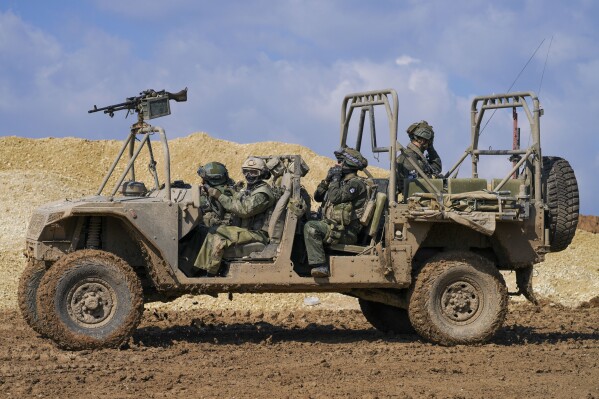Six Messages From Hamas to the Media
As talks of a new, prolonged ceasefire echo against the backdrop of still-raging hostilities between Israel and Hamas, the Palestinian militant group has shared a document outlining six priority areas in its messaging to international media.
The six-page, Arabic-language document, received by Newsweek on Tuesday, breaks down these six points, offering an insight into how the group is vying to win over audiences around the world as a conflict now approaching the four-month mark potentially nears a new phase.
Newsweek has reached out to the Israel Defense Forces (IDF) for comment.
Targeting Civilians
The first point described by the document is the "the continued brutal bombing of citizens' homes in various different areas of the Gaza Strip, and the siege of Nasser Hospital." Here, the group accuses the IDF of ramping up the bombardment of various non-military sites across Gaza, including civilian homes, medical facilities and sites used by United Nations workers.
The IDF, for its part, has repeatedly rejected allegations that it targeted non-combatants and has accused Hamas and allied Palestinian factions of embedding themselves among the civilian population in Gaza, even using human shields. Hamas has vehemently denied this, along with accusations of mass atrocities allegedly committed by its fighters during the initial October 7 surprise attack on Israel.
'Catastrophic' Humanitarian Situation
The second point raised by Hamas is "the humanitarian situation, the worsening famine in the northern regions and the catastrophic situation facing the displaced." In this regard, Hamas discusses the increasingly difficult living conditions that Gaza's roughly 2.2 million residents are facing in the throes of the deadliest-ever flare-up of the decades-long Israeli-Palestinian conflict.
While the IDF and Hamas have accused one another of being the primary cause behind the deteriorating humanitarian situation in Gaza, both sides have acknowledged that things are getting worse, as have a number of international organizations, including the U.N., and foreign powers, even Israel's ally, the U.S.
A key component of the last successful, week-long ceasefire reached in late November and any potential new deal on the table would be securing more aid for Gaza, including food, water, medicine and fuel for the embattled territory. However, the terms of this assistance remain contested. Also vital would be a prisoner exchange entailing the release of Hamas-held hostages in Gaza and Palestinians currently in Israeli jails.
Battlefield Performance
The third key area for Hamas is "the [battle]field situation and the heroic Al-Qassam response, on the fighting fronts, especially Khan Younis, west of Gaza City." The group here sought to stress that its military wing, the Al-Qassam Brigades, and allied Palestinian factions were still very much in the fight, despite IDF advances across Gaza, and that they continued to inflict serious casualties against their foe, both in terms of human and material losses.
As is the case with many conflicts across the globe, assessments of how the war is actually going vary dramatically between the two sides. The unprecedented Hamas-led October 7 air, land and sea assault that sparked the conflict marked a major blow to Israel's image of an advanced, impregnable security state, an image already marred by worsening internal clashes that had mounted for the past year and a half.
But having completed the arduous task of re-securing border areas in the south, the IDF managed to bring the war to Gaza itself, threatening Hamas' own grip on power. Now, as the conflict continues to drag on, uncertainty reigns over how Israel will ultimately complete its stated goal of defeating the group once and for all, and what that means for Hamas' own future.
New Ceasefire
The fourth point put forward by Hamas was "discussions to stop the aggression against Gaza and Zionist intransigence." This section directly addresses the ongoing effort to establish a new ceasefire, but warns against any "hostile" reports that blame Hamas for obstructing talks toward an immediate, lasting cessation of hostilities and instead holds Israel responsible for standing in the way of a new deal.
Israeli Prime Minister Benjamin Netanyahu has stated on a number of occasions that he fully intended to press on with the war until victory. That being said, ongoing discussions, mediated by Qatar and Egypt, indicate a willingness from both sides to find at least a temporary solution to halt the conflict. Meanwhile, ceasefire talks are also at the top of U.S. Secretary of State Antony Blinken's agenda as he conducts his fifth trip to the Middle East since the war began.
Shortly after the Hamas press document was shared, Hamas issued a separate statement Tuesday confirming its response the ceasefire framework that is currently being discussed. The group said it "dealt with the proposal in a positive spirit, ensuring a comprehensive and complete ceasefire, ending the aggression against our people, ensuring relief, shelter, and reconstruction, lifting the siege on the Gaza Strip, and completing a prisoner exchange."
"We value the role of our brothers in Egypt, Qatar, and all countries that seek to stop the brutal aggression against our people," the Hamas statement said.
"As we salute our people and their legendary steadfastness and valiant resistance, especially in the Gaza Strip," the statement added, "we affirm that we in the Hamas movement and with all national forces and factions are continuing to defend our people, on the path to ending the occupation and realizing their legitimate national rights to their land and sanctities."
The final two points mentioned by Hamas focus outside of Gaza and instead on other fronts in which violence has mounted as a direct result of the conflict.
West Bank Violence
The fifth section, entitled "Crimes of the occupation in the West Bank, and the call of its people for an intifada in the face of the occupation and its settlers," draws attention to a spike in Israeli-Palestinian violence in the West Bank, which is partially administered by the Palestinian National Authority (PA) but is mostly subject to Israeli control.
Hamas amplifies long-seething frustration among Palestinians living in the West Bank, some of whom have formed independent armed factions opposed to both Israel and the PA, and the growing threat of a new intifada, or uprising. Two previous intifadas erupted in 1987 and 2000, lasting years and killing hundreds of Israelis and thousands of Palestinians.
Neither these two bouts of unrest, nor four previous wars in Gaza, however, amount to the number of dead since the outbreak of the current conflict. Israeli officials have estimated around 1,200 people were killed in the initial October 7 attack against Israel, with more than 200 Israeli troops killed in the ensuing operations. Palestinian casualty counts provided by officials in Hamas-led Gaza exceed 27,500 dead.
While the U.S. has fully backed Israel's war effort, though not without calls for the IDF to do more to avoid civilian casualties, the actions of Israeli settlers in the West Bank has proven a growing source of contention.
President Joe Biden's decision last week to issue sanctions against four settlers accused of stoking violence against Palestinians marked a public acknowledgement of this issue, though it fell short of taking action against Israeli officials openly backing settlers.
US Air Raids in Middle East
The sixth point issued by Hamas touches upon an even further, yet potentially more volatile front, that of "American [air] raids against Yemen, Syria and Iraq, and the continued targeting of the occupation's interests and its supporters in the region."
Here, the group praises campaigns led by two other Iran-aligned "Axis of Resistance" factions, Yemen's Ansar Allah, also known as the Houthi movement, and the Islamic Resistance in Iraq, a coalition of Iraqi militias, and condemns intensifying U.S.-led military operations against them.
Ansar Allah's drone and missile campaign against commercial vessels transiting critical trade routes off the coast of Yemen and the Islamic Resistance in Iraq's near-daily drone and rocket attacks against U.S. troops in Iraq and Syria have drawn the U.S. deeper into the conflict, threatening to ignite the very kind of broader war that both Washington and Tehran have said they sought to avoid.
Ansar Allah and the Islamic Resistance in Iraq have said they would halt their respective campaigns should Israel end its offensive in Gaza. It remains to be seen, however, whether even a new ceasefire deal, especially a limited and temporary one, would be enough to extinguish the flames now raging across the Middle East as a consequence of the war.
A version of this article initially appeared in the February 6, 2024, edition of Newsweek's Israel at War newsletter.
Update 2/6/24, 3:30 p.m. ET: This article was updated to include a new statement from Hamas explaining the group's response to the ongoing ceasefire discussions.
Disclaimer: The copyright of this article belongs to the original author. Reposting this article is solely for the purpose of information dissemination and does not constitute any investment advice. If there is any infringement, please contact us immediately. We will make corrections or deletions as necessary. Thank you.

